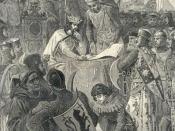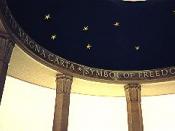The Nevada Constitution has many similarities to the U.S. Constitution and some of the concepts and provisions of the Nevada Constitution have roots that go back to English common law. I will attempt to analyze the evolution of individual rights and liberties in England and in the Colonies and States of the Confederation during the years preceding the Constitutional Convention held in Philadelphia in 1787.
The historical and philosophical roots of the U.S. Constitution started with the kings of England and the Magna Carta that gave power back to the people. Before the Magna Carta was won from King John in 1215, kings had enjoyed a divine right. This divine right allowed the king to rule over all of his people, at his whim, through the use of common law and his royal courts. In 1066, the Norman Conquest had ended the age of liberty for England. Henry II came to power in 1154 and restored the royal courts and common law.
The Magna Carta was intended to protect the liberties of the landed aristocracy. What it did, in effect, was to put the rights of common people in writing. By 1300, the Parliaments had been formed under Henry III and Edward I. Henry VIII and Elizabeth I used the Parliament to break with the Roman Catholic Church and establish the Church of England. Charles I agreed to a Petition of Rights in 1628 that listed the rights of the people. The Habeas Corpus Act of 1679 specified the rights of the accused during judicial proceedings. In 1689, William and Mary were declared King and Queen. They introduced a Declaration of Rights and the Toleration Act. The Act of Settlement was enacted in 1701. Each of these documents led the way for the U.S. Constitution by increasingly giving more rights...


